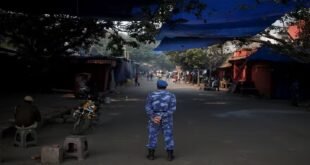09-10-2024
SINGAPORE CITY: A pair of red shoes, two beaded necklaces and a British 10p coin are among the few clues that could help to identify a teenage girl found murdered in western France more than 40 years ago.
Her death is one of 46 cold cases European police are seeking to solve as part of the second phase of a campaign aimed at finding the names of unidentified murdered women.
 “We want to identify the deceased women, bring answers to families, and deliver justice to the victims,” Jürgen Stock, secretary-general of Interpol, which is coordinating the effort, said in a statement on Tuesday.
“We want to identify the deceased women, bring answers to families, and deliver justice to the victims,” Jürgen Stock, secretary-general of Interpol, which is coordinating the effort, said in a statement on Tuesday.
“Whether it is a memory, a tip, or a shared story, the smallest detail could help uncover the truth.”
The second phase of the Operation Identify Me campaign includes cases in the Netherlands, Germany, Belgium, France, Italy and Spain.
Details of each one have been published on Interpol’s website, along with photographs of possible identifying items and facial reconstructions.
Most of the victims are thought to have been aged between 15 and 30.
The body of the teenager with red shoes, beaded necklaces and a 10p piece was found underneath layers of leaves in a layby near a village called Le Cellier in 1982. It had been there for several months.
Speaking near the area she was found, now overgrown with brambles, nettles and horse chestnut trees, detective Franc Dannerolle says the teenager’s body was “disposed of like garbage”.
“There was no respect, no care for her before her death,” he adds.
The 10p coin led investigators to believe that she was either British or had been travelling in Britain before her murder, though they acknowledge that she could have found it, or been given it.
Police have chosen not to go into detail about the nature of her killing to avoid “fake perpetrators” from claiming responsibility.
 Unfortunately, the teenager’s remains can no longer be found, which complicates the cold case investigators’ task.
Unfortunately, the teenager’s remains can no longer be found, which complicates the cold case investigators’ task.
“If we manage to find them, it could be possible to work on her DNA to have a link with the family,” says Det Dannerolle.
Retired detective Alain Brillet worked on the case at the time and describes it as a “triple enigma”.
“The strangest and most incredible thing was that we had someone who had been murdered, because we knew she had been murdered, but we could never find out what her name was, where she was from, or who had killed her,” he says.
The media found one woman who recalled the fear the discovery of her body sparked in the village, but because the victim wasn’t local, most people forgot about it and moved on.
The launch of the Operation Identify Me campaign last year marked the first time that Interpol had ever gone public with a list known as “black notices”, seeking information about unidentified bodies. Such notices had historically only been circulated internally among Interpol’s network of police forces.
Across Europe, the ease of movement due to open borders, increased global migration, and human trafficking has led to more people being reported missing outside their home country, says Dr Susan Hitchin, co-ordinator of Interpol’s DNA unit.
“These women have suffered a double injustice. They’ve become victims twice: they’ve been killed through an act of violence and they’ve been denied their name in death,” she says. (Int’l News Desk)
 Pressmediaofindia
Pressmediaofindia




